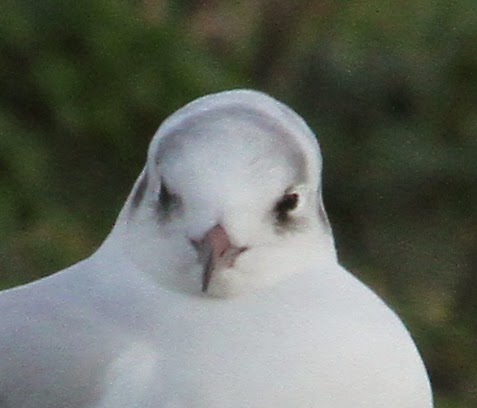The water level in Barden Lake has slowly and gently dropped, and you can now walk all the way around, muddy though it is. On the Fishing Lake by the cafe block, there were some a couple of nice Tufted Ducks, Aythya fuligula, 2 males. This bird does not have an obvious crest, but I think must still be older than a first winter juvenile, as there is no barring on the flanks. The water droplets still clinging to the feathers may indicate that the bird has recently surfaced and the crest may then be slicked down in consequence.
Other interesting ID features are the interestingly shaped head with the high forehead on a relatively narrow neck. The bill has a good solid black tip or nail (across the cross-section of the bill, looking as though it "has been dipped in ink"). There is more than a hint of a whitish stripe across the front of the bill, contrasting with the blue-grey on the rear part of the bill. The bird is said to sit low in the water but with its tail above the surface, and I think I would agree with this from this picture to some extent - it looks as though its sitting a bit lower in the water at the moment, per haps after a dive. Deep yellow eye, perhaps slightly out of focus. The contrast between the dark wing and the white sides is nice and distinct, a beautiful bird indeed, moving well across the water!.
On the main Gravel Pit, Barden Lake, other individuals were keeping themselves out of trouble. This one looks very much at rest, but with its eyes open! I think that the wings are most easily seen from this angle, with the two sets of primary feathers forming a valley down the back between the two wings. It also looks to me as though the flank feathers somewhat overlie the sides of the wings, giving that fringed effect to the rear of the white sides. The tail sits slightly cocked in this picture.
According to the BTO, "the rapid expansion of the Tufted Duck in Britain during the late 19th/early 20th century is probably due to the colonisation of Britain by Zebra Mussels (brought into London docks in the 1820s)". The birds are omnivorous, feeding mainly on mussels, insects and plant material taken from the muddy bottoms of the water bodies they are on, diving anywhere between 4 - 15 metres down. It breeds better if there aren't excessive numbers of fish.
The females show the same amount of darkening at the top of the biill, with a little light band just behind. Some of them show a scaup-like white patch at the base of the bill, although not quite so extensive, and I rather think quite a lot of them show some degree of lighter brown in that area, like the one in the duck below.
























